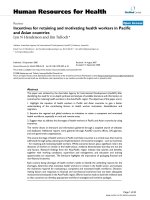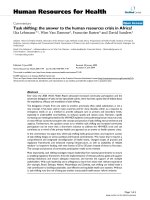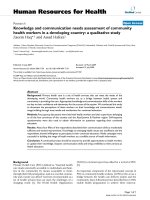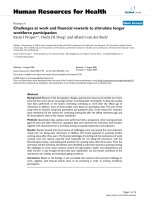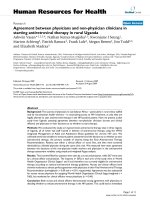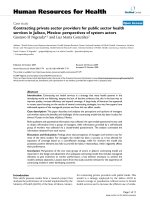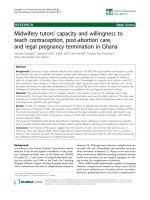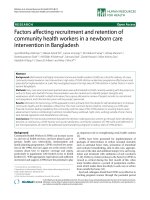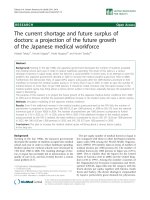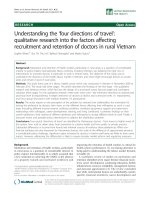báo cáo sinh học:" Factors affecting recruitment and retention of community health workers in a newborn care intervention in Bangladesh" pptx
Bạn đang xem bản rút gọn của tài liệu. Xem và tải ngay bản đầy đủ của tài liệu tại đây (707.63 KB, 14 trang )
Rahman et al. Human Resources for Health 2010, 8:12
/>Open Access
RESEARCH
BioMed Central
© 2010 Rahman et al; licensee BioMed Central Ltd. This is an Open Access article distributed under the terms of the Creative Commons
Attribution License ( which permits unrestricted use, distribution, and reproduction in
any medium, provided the original work is properly cited.
Research
Factors affecting recruitment and retention of
community health workers in a newborn care
intervention in Bangladesh
Syed Moshfiqur Rahman
†1
, Nabeel Ashraf Ali
†1
, Larissa Jennings
†2
, M Habibur R Seraji
1,2
, Ishtiaq Mannan
1,2
,
Rasheduzzaman Shah
1,2
, Arif Billah Al-Mahmud
1
, Sanwarul Bari
1
, Daniel Hossain
1
, Milan Krishna Das
1
,
Abdullah H Baqui
1,2
, Shams El Arifeen
1
and Peter J Winch*
†2
Abstract
Background: Well-trained and highly motivated community health workers (CHWs) are critical for delivery of many
community-based newborn care interventions. High rates of CHW attrition undermine programme effectiveness and
potential for implementation at scale. We investigated reasons for high rates of CHW attrition in Sylhet District in north-
eastern Bangladesh.
Methods: Sixty-nine semi-structured questionnaires were administered to CHWs currently working with the project, as
well as to those who had left. Process documentation was also carried out to identify project strengths and
weaknesses, which included in-depth interviews, focus group discussions, review of project records (i.e. recruitment
and resignation), and informal discussion with key project personnel.
Results: Motivation for becoming a CHW appeared to stem primarily from the desire for self-development, to improve
community health, and for utilization of free time. The most common factors cited for continuing as a CHW were
financial incentive, feeling needed by the community, and the value of the CHW position in securing future career
advancement. Factors contributing to attrition included heavy workload, night visits, working outside of one's home
area, familial opposition and dissatisfaction with pay.
Conclusions: The framework presented illustrates the decision making process women go through when deciding to
become, or continue as, a CHW. Factors such as job satisfaction, community valuation of CHW work, and fulfilment of
pre-hire expectations all need to be addressed systematically by programs to reduce rates of CHW attrition.
Background
Community Health Workers (CHWs) can increase access
to, and use of, health services, and have played a part in
primary health care, tuberculosis, immunization and
family planning programmes. CHWs received less atten-
tion in the 1990s, but now again are at the centre of dis-
cussions about how to improve coverage and equity,
particularly in populations with limited access to health
facilities [1]. With appropriate expectations and sufficient
investment and support, CHWs have the potential to play
an important role in strengthening weak health systems
[2].
CHWs have been promoted for implementation of
packages of interventions to reduce neonatal mortality
such as antenatal home visits, promotion of immediate
and exclusive breastfeeding, skin-to-skin care, appropri-
ate care of the skin and umbilical stump [3-6], and recog-
nition and treatment with antibiotics of sick newborns
[7-10]. Delivery of interventions in the home by CHWs is
viewed as critical during the first month of life, when
many families observe a period of postpartum confine-
ment which makes them less likely to seek care or advice
from outside the home [11].
Syed and colleagues found that CHWs were effective in
tracking pregnant women through the postnatal period
* Correspondence:
2
Department of International Health, Johns Hopkins Bloomberg School of
Public Health, Baltimore, Maryland USA
†
Contributed equally
Full list of author information is available at the end of the article
Rahman et al. Human Resources for Health 2010, 8:12
/>Page 2 of 14
and in raising awareness of appropriate maternal and
newborn care practices [12]. Implementation of newborn
care interventions is relatively complex compared to
CHW-based interventions, such as the mass treatment of
endemic diseases and the promotion of preventive ser-
vices such as immunizations. To be effective, CHWs must
gain mastery of a range of information and skills related
to maternal and newborn care, and know how to adapt
counselling strategies to households with varied compo-
sition and needs [3]. This, in turn, requires greater invest-
ment by programmes in CHW selection and training.
The term 'community health workers' can refer to a
variety of health care providers such as village health
workers, community resource people, traditional birth
attendants or workers known by local names. While these
providers are trained, they typically do not have any pro-
fessional certification [1]. CHWs can deliver a variety of
community-based health care services, and are particu-
larly important in areas where the use of facility-based
services is low.
Haines and colleagues propose four determinants of
the success of a CHW programme: 1) national socioeco-
nomic and political factors, including corruption and
political will; 2) community factors such as location and
infrastructure and health beliefs; 3) health system factors
such as remuneration and supervision, and 4) interna-
tional factors including migration flow and technical
assistance [1]. CHWs require supportive supervision,
clearly defined roles with specific tasks, locally relevant
incentive systems that combine monetary and non-mon-
etary incentives, recognition, training opportunities,
community and policy support, and strong leadership
[13,1]. All of these factors can play a role in the length of
time a worker serves as a CHW.
In addition to the factors listed above, individual CHW
motivation impacts retention and attrition. Motivation is
driven by many elements including intrinsic factors such
as an individual's work-related goals, as well as his/her
sense of altruism, self-efficacy, and organizational com-
mitment. Extrinsic factors include peer approval, the
incentives provided, and the expectation of future paid
employment [14-18]. These are similar to the factors
found to affect motivation and retention of formally
trained health workers in low income countries in a
recent review [19].
Significant rates of attrition undermine programmes'
investments in CHWs, and potentially limit the effective-
ness of community-based interventions aimed at reduc-
ing neonatal mortality. Higher attrition rates are
associated with volunteers [14]. One review reported that
CHWs dependent on community financing are two times
more likely to leave their posts than health workers com-
pensated by government salaries [20]. A study in Bangla-
desh found reasons cited by CHWs for leaving their posts
included lack of time to attend to their own children and
other responsibilities, insufficient profit/salary, and their
families' disapproval [21]. Another study in Nigeria found
that village health workers stopped working because of
low salaries, a lack of opportunity for advancement, a lack
of credibility with the villagers, and poor supervision
[22].
Henderson and Tulloch identified a number of key rec-
ommendations for retaining salaried health-workers [23].
Recommendations such as "improved working and living
conditions," "improved supervision and management,"
clarifying "job descriptions, criteria for promotion, and
career progression," "increasing education, training and
professional development opportunities" and "social rec-
ognition" are applicable to both paid and volunteer work-
ers [23]. Conversely, recommendations such as "strategies
for return migration," "bonding and mandatory service"
and "payment systems" are not relevant to CHWs [23].
While the recommendation of increasing salaries is not
applicable to CHWs, increasing "benefits and allow-
ances," as well as "performance-based non-financial
incentives," of CHWs could increase retention [23].
Other studies suggest that strong social networks and
social cohesion are important factors for CHW retention,
and that CHWs benefitting from strong support system
at the community level that validates their work and their
role are more likely to continue in that role despite other
potentially negative factors [24].
A newborn care intervention trial ("Projahnmo-1"),
conducted in Sylhet District in north-eastern Bangladesh,
evaluated the effectiveness of two different service deliv-
ery models of a package of maternal and newborn care
interventions [25,26,9,10]. CHWs were the cornerstone
of one of the community-based delivery strategies imple-
mented in the Home Care intervention arm. In this arm,
CHWs were the first level of health-workers engaged in
service provision, serving a population of 4000, which is
approximately 800 households. For pregnancy surveil-
lance, each CHW spent on average two hours to cover 20
households. This was intended to replicate the coverage
area of a similar cadre of governmental health workers.
CHWs worked at the household and family level to pro-
mote Birth and Neonatal Care Preparedness. Addition-
ally, they ensured the provision of safe delivery care, as
well as essential newborn care during and after birth, by
maintaining active coordination with the traditional and/
or family birth attendants and the individual identified by
the family to care for the newborn immediately following
birth. The role of the CHW in this trial was involved and
often complicated. Participating CHWs not only needed
to be skilled technically and adept in clinical assessment,
but they also were required to develop superior counsel-
ling skills - which were arguably equally important to
their clinical skills.
Rahman et al. Human Resources for Health 2010, 8:12
/>Page 3 of 14
CHWs were offered a remuneration package of 3200
Bangladeshi taka per month, which is equivalent to US$
45 dollars. They were expected to work from eight in the
morning to four in the afternoon six days a week, with
newborn care visits to be made within the first day of life,
even if that meant visiting the household on a holiday.
Their work also involved paying informal unscheduled
visits to households when and if families needed their
assistance, especially when attending a sick neonate. The
remuneration package did not include a scheduled incre-
mental increase. Therefore, though it was comparable to
that of other similar governmental job opportunities in
the beginning (i.e. working as a Family Welfare Assistant
or FWA), after a year there was a marked difference
between their salary and that of the government FWAs.
In implementation of the Home Care intervention arm,
CHW attrition was identified early on as a significant
constraint on the effectiveness of the intervention pack-
age. This paper explores the causes of attrition, as well as
how CHW attrition was analyzed and addressed by this
community-based newborn care intervention in rural
Bangladesh.
Methods
Sylhet is known to be a relatively conservative region of
Bangladesh. Recruiting women for a CHW position, a
type of work unfamiliar to the community, proved to be
difficult at first. Initially the Sylhet project planned to
recruit married women with 10 or more years of educa-
tion to serve as CHWs. The educational requirement was
necessary because of the detailed record forms CHWs
had to complete as part of the study. Due to the shortage
of married women with the requisite educational back-
ground, along with the initial reluctance of women to
serve as CHWs in general, the project ultimately
recruited single women.
A total of 41 CHWs were recruited at the beginning of
the intervention in Sylhet District who fulfilled the fol-
lowing criteria:
1) female,
2) local resident in the area of assignment,
3) preferably married (this criterion was dropped
when it proved impossible to identify sufficient num-
bers of eligible married women),
4) aged between 20 and 40, and
5) secondary school leaving certificate (SSC pass).
Initially there were 38 CHW service areas (areas cov-
ered by one CHW), thus three CHWs were available to
serve as replacements in the event of attrition among the
other 38 CHWs. In the early months of the project, two
service areas were deemed too large for effective coverage
by 1 CHW, and were subsequently divided, ultimately
resulting in 40 CHW service areas.
CHWs were recruited through advertisements placed
in a local newspaper. Candidates meeting the criteria sat
for a written general knowledge examination that covered
questions such as: "What are the main child health prob-
lems in Bangladesh?" and "What is an NGO?". Candidates
who passed the written examination were interviewed at
the project office. If they passed the interview and agreed
to work they then received six weeks of training. After
training they were evaluated on maternal and newborn
care knowledge and relevant skills for intervention.
Initial CHW responsibilities included visiting assigned
households to identify pregnant women (pregnancy sur-
veillance). Subsequently, CHWs began providing regis-
tered pregnant women with birth preparedness messages
and materials. Attending deliveries, attending sick new-
borns, referral of women and newborns to care, and, in
the case of referral failure, treatment of sick newborns in
the home with injectable antibiotics [10], as well as filling
out forms, were other tasks added over time.
Over the course of the four-year project, a total of 73
CHWs were recruited either initially (41 CHWs) or later
on to replace CHWs who left the project, requiring addi-
tional efforts by the programme to recruit and train
replacement CHWs. The total period of intervention was
36 months. Thirty-two CHWs (referred to as former
CHWs in this paper) left the project during this period, of
whom 15 left within one year, and another 10 by the end
of the second year of the project. Training of the replace-
ment CHWs had a higher unit cost, because they were
trained on an on-going basis, sometimes only a few at a
time. Dedicated trainers were initially recruited for the
project only on a short-term basis, thus the responsibility
for training new CHWs fell to the supervisors in the later
phase of the project. This proved extremely difficult,
given their routine programme responsibilities. The proj-
ect took the following steps in order to address the prob-
lem:
• Project staff, including senior level managers, visited
the houses of CHWs and talked with their parents
and guardians, communicating the aims and activities
of the programme and emphasizing the benefits to
the community as well as to their daughter/s.
• From the outset of the project, staff of the imple-
menting non-governmental organization partner
(Shimantik) held community advocacy meetings to
explain the project and respond to community con-
cerns. The NGO added a new step of initiating dia-
logue with the parents and guardians of the new
CHWs at the time of recruitment in order to explain
the project and roles of the staff members.
• A number of field-level workers were given the
opportunity to become supervisors based on exem-
plary performance.
Rahman et al. Human Resources for Health 2010, 8:12
/>Page 4 of 14
• A number of incentives were created, such as incen-
tives for the CHWs to attend deliveries at night.
Data from three different sources are presented. The
first source is employment records of CHWs in the new-
born care intervention trial in Sylhet District [9], with
mention of differences with another trial in Tangail Dis-
trict, Mirzapur Subdistrict (Table 1) [27].
The second source of data is a survey of factors affect-
ing retention and attrition administered to 69 of the 73
current and former CHWs in Sylhet District. Semi-struc-
tured questionnaires were administered in 2005 to CHWs
currently employed and those who left the job in order to
elicit information on job satisfaction, demands, and aspi-
rations. This was a self-administered questionnaire in
which, after a brief explanation of how the questionnaire
was arranged, respondents were asked to complete it
based on their interpretation. The self-administered
questionnaire for CHWs had 45 questions, divided into
four parts: 1) Personal and family history, 2) Motivation
behind CHW work, 3) Experiences related to CHW
work, and 4) Reasons for leaving. There were both multi-
ple-choice and open-ended questions. A mid-level man-
ager who was not directly supervising the CHWs was
chosen as the facilitator for the self-administered ques-
tionnaires. The respondents were all
CHWs, both those
who had left and those still working for the project.
CHWs were given complete freedom to respond as they
saw fit. CHWs were given the confidence and assurance
that their names would be removed at the time of analysis
of the data. Data were further strengthened by informal
discussions with field managers and supervisors aimed at
gaining insight from their field experiences. Finally, data
are included from a complementary qualitative process
documentation exercise consisting of in-depth inter-
views, focus group discussions, a review of project
records (i.e. recruitment and resignation), and informal
discussion with key project personnel.
Results
Demographic characteristics of CHWs in Sylhet
Table 1 displays CHW demographic characteristics and
patterns of recruitment and retention in Sylhet District.
Compared to CHWs in a similar project in Tangail Dis-
trict in central Bangladesh, CHWs in Sylhet were signifi-
cantly younger (mean age 26.8 years in Tangail versus
23.3 years in Sylhet, p < 0.001) and much more likely to be
unmarried (25.0% in Tangail versus 61.6% in Sylhet, p <
0.001).
Recruitment and retention of CHWs
Rates of CHW attrition were far higher in Sylhet than in
Tangail over the 36-month period of the two projects
(2004-2006). In Sylhet 52.5% of the 40 CHW service areas
Table 1: CHW demographic characteristics and patterns of
recruitment and attrition in Sylhet District, Bangladesh
Demographic
characteristics
Total CHWs employed over
life of project
73 CHWs
Mean age of CHWs (Standard
deviation)
23.3 (4.3)
Frequency (Percent)
Marital status at time of
recruitment
Unmarried 45 (61.6)
Married 19 (26.0)
Divorced/separated 9 (12.3)
Years of education at time of
recruitment
9 years 1 (1.4)
10 years 54 (74.0)
12 years 17 (23.3)
14 or more years 1 (1.4)
Patterns of recruitment
and attrition
Number of CHW service areas
(zone covered by 1 CHW)
40 areas
Service areas with same
CHW from start to end
21 areas (52.5)
Service areas with CHW
attrition during project
19 areas (47.7)
CHW attrition during the
project
No attrition: CHW
worked until end of
project
40 (54.8)
Attrition initiated by
CHW and/or family
26 (35.6)
Attrition initiated by
project
7 (9.6)
Reasons for attrition initiated
by CHW or family
Rahman et al. Human Resources for Health 2010, 8:12
/>Page 5 of 14
had the same CHW from the beginning to end of the
project (Table 1), compared to 69.4% of the 36 CHW ser-
vice areas in Tangail. A total of 73 CHWs were employed
over the life of the project in Sylhet. The primary reasons
for CHW attrition are grouped into 4 categories: family
reasons, work-related reasons, education opportunities,
and actions taken by the project. Of the four categories,
family-related reasons are the most important, notably
opposition by families to daughters working as CHWs,
and CHWs ceasing to work after marriage. Six CHWs left
when they obtained government positions, most notably
work as primary school teachers (Table 1). Four CHWs
were promoted to supervisory positions, and three were
fired due to poor performance (Table 1). Promotion was
one strategy adopted by the project to retain the best
CHWs. There were no significant associations with age,
marital status and education between CHWs who left the
project and those who continued until the end. This is
partly to be expected, because the selection criteria for
CHWs resulted in a group of CHWs being selected that
had little variation in these variables.
Factors influencing decision to become a CHW
Tables 2, 3 and 4 present data from the survey of 69 of the
73 current and former CHWs conducted at the Sylhet site
in 2005. This survey excludes the four replacement
CHWs hired subsequently. Table 2 displays factors influ-
encing the decision to become a CHW. The two group-
ings of factors most commonly cited in Table 2 are self-
development (desire to improve skills) and the desire to
improve community health. Other factors which moti-
vate women to serve as CHWs are: the desire to use avail-
able time productively and, less commonly, value and
recognition from the community and aspirations for
financial independence. Most differences were non-sig-
nificant, in part due to limited statistical power. Former
CHWs were significantly more likely to say that family
and friends encouraged them to apply for the job (p =
0.022), that they knew much time would be required, but
they had a lot to offer (p = 0.024), and that they wanted to
learn about maternal and newborn care (p = 0.039).
Reasons given by CHWs for continuing to work
Table 3 shows reasons given by current CHWs in the sur-
vey in Sylhet for continuing to work. The financial incen-
tive was the biggest motivating factor (95%) for retention,
though it did not rank among the top reasons the women
chose to become CHWs. Also prominent reasons for con-
tinuing to work were the recognition derived from being
needed by the community (86%) and the expectation of
landing a better job due to the experience gained as a
CHW (86%). Less frequently, CHWs mentioned enjoy-
ment associated with the work, and support and encour-
agement by family and supervisors as motivating factors.
Data on CHW retention were also collected from a pro-
cess documentation exercise carried out mid-way
through the project at the Sylhet site. Respondents were
asked why they became CHWs, and the majority
explained that they wanted to help improve newborn and
maternal health in their community. Beyond the benefits
of employment, many CHWs anticipated that the posi-
tion would positively impact their families and neigh-
bours, as well as their own personal lives. For many of
these women, "work is good; whatever it is. Joblessness is
a curse." For most CHWs, this was their first job, and
many considered it to be a gateway to future work. Two of
the CHWs explained:
"Initially it was only money, but later I figured that
this job may help me in the future to get better jobs.
Maybe someday I will be able to become a para-
medic."
CHW left for family reasons 14
Marriage 11
Family opposed to her
working as CHW
3
Husband got work in Dhaka 0
CHW left for work-related
reasons
11
Left to take other position 6
Workload considered too
heavy
2
Wanted promotion but not
granted
2
Wanted to change to other
service area
1
CHW left to pursue higher
education
1
Reasons for attrition
initiated by project
Promoted to higher position
with project
4
Terminated due to poor
performance
3
Sample: All 73 current and former CHWs in the project, working
in 40 CHW service areas.
Table 1: CHW demographic characteristics and patterns of
recruitment and attrition in Sylhet District, Bangladesh
Rahman et al. Human Resources for Health 2010, 8:12
/>Page 6 of 14
"If I get another job, be it a government job or not, I
would like it to be related to health, since I know a lot
about health now."
The ability to make financial contributions to the family
is a substantial impetus in CHW retention, despite con-
cerns about the heavy workload and discomfort with the
evening and holiday travel required by the job.
Many CHWs expressed interest in pursuing future
employment as another type of health care provider and
doing work such as delivering babies, becoming a para-
medic, or working for the government as a community or
facility-based health worker. A few hoped to work as a
government school-teacher. Additional motivating fac-
tors included meeting other women with similar interests
and goals. Several CHWs expressed desires of indepen-
dence and the ability to help provide financially for their
families: for their husbands and children (for those who
were married) and for their siblings (for those who were
unmarried). Despite attempts at saving money, CHWs
reported difficulty especially in the few cases where
CHWs were recruited outside their cluster areas and thus
were required to pay rent by their jobs.
In-depth qualitative interviews suggest that CHWs
would recommend CHW work to a relative or friend, as
long as all the relevant aspects of the job were explained
in advance. Women said that they would stress the
importance of CHW work in reducing neonatal mortality
in the community, the opportunity for the CHW to
expand her knowledge of health-related matters, and the
benefit of having a monthly salary. Two CHWs felt that
the role of CHW increased women's independence and
marketability for better-paying jobs, although concerns
were raised about the response of the community and
overall handling of the workload:
"I would recommend the CHW job, but I will let them
know everything, including how hard it is. I would
also warn them of problems with not being paid travel
bills regularly. If she likes what I say, then she will go
ahead and work."
CHW job satisfaction and work-related challenges
Table 4 from the CHW survey displays responses to ques-
tions on the CHW survey in Sylhet District on job satis-
faction and work-related challenges. Two challenges to
carrying out the work are mentioned significantly more
often by current CHWs than former CHWs: the necessity
of making visits at night to attend deliveries (p = 0.0058),
and experiencing the death of a newborn (p = 0.017).
Other challenges commonly cited that do not differ sig-
nificantly between current and former CHWs include
dissatisfaction with pay, underestimation of required time
for CHW-related work, working outside of one's home
area; and familial opposition to CHW work. In in-depth
interviews, former CHWs were more likely to report that
the CHW job did not meet their expectations for self-
development or value and recognition. They were also
more likely to be dissatisfied with their remuneration and
less likely to attribute CHW experiences to being recog-
nized or valued by the community.
Most current and former CHWs noted in in-depth
interviews that movement throughout all parts of the
community was a problem, both for them and for their
families. Some of the CHWs commented that they were
initially very reluctant to move around and were referred
to as 'girls' by community members. In the local Sylheti
language, "phuri" meaning girl is used for any unmarried
woman, rather than "mohila" meaning woman. The proj-
ect CHWs were referred to as "phuri" because they were
unmarried.
Current CHWs reported, however, that much of the
initial discomfort and apprehension had dissipated since
many of them began wearing a Muslim headdress
(niqab). Now they feel more confident and move around
alone, taking the bus or any other vehicle to travel to dis-
tant villages.
"Now we are known to the community; otherwise we
wouldn't have been able to work. Some people are
very helpful - they hail rickshaws, boats, or whatever
is needed. They know we are CHWs and are responsi-
ble and alert. It is not bad now"
In in-depth interviews with four former CHWs, con-
cern about moving around the community and familial
disapproval were consistent themes. Some CHWs
explained that their family members are anxious, espe-
cially when they return home late. Others say their fami-
lies worry because they are young and vulnerable to
danger. Many CHWs are even reluctant to discuss the
complete responsibilities of their work with their families,
noting, for example:
"They wonder what kind of job it is that requires
women to stay out so long. If my brother was here in
the country, then I wouldn't be able to work as a
CHW."
"My father is the sufferer He used to be the alternate
imam of the village. Now half of the people do not
want to stand behind him in the prayers. They say his
daughters work for NGOs, which is not right for a
religious person."
Despite the apparent antagonism and disapproval from
families, most have accepted the CHW-work, as a result
of the substantial contribution to the family. When asked
why they had continued working as CHW, the majority
explained that, at best, the job simply "pays". Others
noted reasons for staying similar to their reasons for join-
ing - an opportunity to educate the community on benefi-
cial maternal and neonatal care practices, and general
Rahman et al. Human Resources for Health 2010, 8:12
/>Page 7 of 14
Table 2: CHW survey in Sylhet District, Bangladesh: factors influencing decision to become a CHW
Current
N = 46
Former
N = 23
Total
N = 69
p from Chi-
square
Self-development I expected the
experience will
enhance my
communication
skills.
38 (83%) 17 (74%) 55 (80%) N.S.
I expected to get
involved in the
community.
33 (72%) 15 (65%) 48 (70%) N.S.
I expected I will
have a new sense
of self-pride and
accomplishment.
37 (80%) 18 (78%) 55 (80%) N.S.
I hoped to gain
skills that would
enable me to
work as a health
practitioner.
34 (74%) 20 (87%) 54 (78%) N.S.
I wanted to
eventually work
elsewhere and
knew that field
experience was
required.
28 (61%) 13 (57%) 41 (59%) N.S.
Financial
independence
I needed to earn
money to help
support my
family.
23 (50%) 8 (35%) 31 (45%) N.S.
I wanted to earn
money to save for
school
5 (11%) 2 (9%) 7 (10%) N.S.
Value and
recognition
My family and
friends
encouraged me
apply for the job.
16 (35%) 13 (57%) 29 (42%) 0.022
I knew of other
CHWs who were
respected in the
community.
12 (26%) 4 (17%) 16 (23%) N.S.
I believed
working as a CHW
was a respectable,
honourable job.
29 (63%) 12 (52%) 41 (59%) N.S.
Rahman et al. Human Resources for Health 2010, 8:12
/>Page 8 of 14
good feelings resulting from the ability to provide treat-
ment for sick newborns.
Other reasons for CHW attrition included better job
offers, lack of security with their present job, insufficient
compensation given the breadth of work, discomfort
moving in predominately male settings, and marriage
duties. Many CHWs applied for schoolteacher and Fam-
ily Welfare Assistant positions with the government.
Government posts are highly attractive in Bangladesh,
and CHWs frequently commented on their job's excessive
workload compared with other the government posi-
tions.
Disapproval from families regarding household visits by
male supervisors, problems with travel bills, and overall
dissatisfaction with management styles were other factors
cited. One CHW commented:
"Management used to go overboard - they didn't real-
ize that the job wasn't everything in my life We were
looked at with suspicion whenever we talked to any-
one outside the scope of work. If it was a guy, then
things were simply unbearable, dirty."
CHWs who had left the project had difficulty suggest-
ing what could have been done to influence their deci-
sions to leave. Two women felt, regardless of efforts by
management specifically to encourage them to stay, their
families would not have agreed. Families' perceptions of
the nature of the job made them uncomfortable with their
daughters' position.
"I mentioned this [working as a CHW] to my cousin,
but her father didn't let her work since he heard [the
project] works for family planning."
Discussion
Attrition of CHWs had serious implications for the effec-
tiveness of the package of maternal and newborn care
interventions being tested. High rates of attrition in the
Sylhet site threatened the continuity of the project activi-
ties, both in the field and within the families of the preg-
nant women and newborn babies. High attrition
potentially could adversely impact the project's credibil-
ity, due to irregular and inadequate interaction of the
CHWs with the community. Attrition of CHWs put
strains on project management, due to the intensive
effort required for recruitment, training and supervision
of new CHWs. This project focused heavily on clinical
assessment of the newborn babies, so considerable effort
was needed to ensure adequate training and supervision
by personnel with appropriate clinical skills.
High rates of attrition increased the cost for training
since the original plan was to train around 40 CHWs,
while the project ended up having to train more than 70 -
doubling the projected amount for this purpose. How-
ever, it is noteworthy that attrition is not all negative, and
to some degree, is to be expected. Attrition indicates that
some women were confident enough to seek opportuni-
ties beyond what their local communities offered and
make choices that benefit themselves and their families.
However, measures can and should be taken for the sake
of the project to minimize its rate. The results of this
study, coupled with the experiences in the current second
phase of the Projahnmo project, indicate that newborn
health programmes can proactively address many prob-
lems at the planning stage by ensuring appropriate levels
of remuneration or putting in place alternative systems of
Use of available
time
I wanted to spend
my time
constructively.
23 (50%) 11 (48%) 34 (49%) N.S.
I knew much of
my time would be
required, but I had
a lot time to offer.
20 (43%) 16 (70%) 36 (52%) 0.024
Improve
community
health
I wanted to learn
about newborn
and maternal care
for my own
family.
29 (63%) 20 (87%) 49 (71%) 0.039
I wanted to
improve the
health of the
community.
36 (78%) 22 (96%) 58 (84%) N.S.
Sample: 69 of the 73 current and former CHWs in the project at time of the survey
Table 2: CHW survey in Sylhet District, Bangladesh: factors influencing decision to become a CHW (Continued)
Rahman et al. Human Resources for Health 2010, 8:12
/>Page 9 of 14
incentives, and training supervisory personnel on how to
identify and address causes of attrition.
Factors affecting retention and attrition overlap, but are
not necessarily opposites. Decisions for retention or res-
ignation are based on a complex set of trade-offs between
different factors affecting different individuals differently.
We need to understand how these factors interact and
how the process is triggered. In this paper, we have pro-
posed a general framework for the individual decision
making process with regard to retention and attrition (see
Figure 1).
Figure 1 shows the pre-hire expectations that motivate
a woman to become a CHW, including how the work will
contribute to her self-development, her ability to be
involved with her community, her financial and social
independence, and the community's recognition of her
work. These motivating factors coupled with inputs by
the programme, such as access to training and agreement
with the terms and conditions of employment, determine
whether she becomes a CHW.
Once employed, five key factors influence CHW reten-
tion. The first factor is job satisfaction, which includes
issues such as the amount of work the CHW is expected
to perform, how close her work is to her home, incentives
and costs to being a CHW, as well as the kind of supervi-
sion and operational support she receives. Second is
whether alternative job opportunities become available
that are either more attractive or long-term, rather than
project-based. The third factor is the occurrence of sig-
nificant life events, such as marriage, childbirth, moving
to another community, personal illness, or the occur-
rence of illness or death in the family. The fourth factor is
the value the community attributes to CHW work, and
the existence of other options for health care in the com-
munity. The final factor contributing to CHW retention
is the extent to which her pre-hire expectations were real-
ized. These bear similarities to factors identified in a
recent review on motivation and retention in formally-
trained workers [19].
Table 3: CHW survey in Sylhet District, Bangladesh: reasons given by current CHWs for continuing to work
Percent (%) of CHWs agreeing
Recognition I feel the people in the community need
me
37(86%)
Financial and time allowances I need the money/salary. 41 (95%)
I have time because I am not married. 15 (35%)
Job satisfaction My work is enjoyable. 30 (70%)
I like travelling in the community. 25 (58%)
Support Other CHWs have encouraged me to stay. 18(42%)
My family has encouraged me to stay. 28 (65%)
My supervisor has encouraged me to stay. 28 (65%)
I have someone to help me with my duties
at home.
23 (53%)
Personal development Working as a CHW will help me get a better
job.
37 (86%)
I applied for more education or another
job, but have not/will not receive it.
4 (9%)
Sample: 43 of 46 current CHWs in the project at the time of the survey
Rahman et al. Human Resources for Health 2010, 8:12
/>Page 10 of 14
Table 4: CHW survey in Sylhet District, Bangladesh: job satisfaction and challenges related to work among current and
former CHWs
Current
N = 46
Former
N = 23
Total
N = 69
p from Chi-
square
Fulfilment of pre-hire expectations
Self-development I have enhanced
my
communication
skills.
38 (83%) 18 (78%) 56 (81%) N.S.
I have enjoyed
working in the
community.
27 (59%) 12 (52%) 39 (57%) N.S.
I have a new sense
of self-pride and
accomplishment
from my job.
35 (76%) 18 (78%) 53 (77%) N.S.
I feel that I have
adequate field
experience to
qualify for other
public health
jobs.
32 (70%) 15 (65%) 47 (68%) N.S.
Dissatisfaction
with pay
I think I should be
paid more.
39 (85%) 20 (87%) 59 (86%) N.S.
I do not have
enough money to
cover my work-
related expenses.
22 (48%) 13 (57%) 35 (51%) N.S.
Recognition and
contribution to
community
health
Newborn family
valued my night
attendance to
delivery or
newborn illness.
29 (91%)
a
7(88%)
a
36 (90%)
a
N.S.
Newborn family
valued my care
even in the event
of a neonatal
death
27 (90%)
b
7 (88%)
b
34 (89%)
b
N.S.
I am proud to be a
CHW and feel that
my work is valued.
32 (70%) 14 (61%) 46 (67%) N.S.
Rahman et al. Human Resources for Health 2010, 8:12
/>Page 11 of 14
Use of time The job has
required the
amount of time
than I expected it
would.
27 (59%) 14 (61%) 41 (59%) N.S.
Challenges in serving as CHW
Difficult aspects
of work
Conducted night
visits for delivery
or illness
32 (70%) 8 (35%) 40 (58%) 0.0058
Experienced
death of newborn
under her care
30 (65%) 8 (35%) 38 (55%) 0.017
Working outside
home community
or area
11 (24%) 7 (30%) 18 (26%) N.S.
Familial reaction
to night work or
work outside
home area
My family
discouraged and/
or questioned
necessity of my
conducting night
visits.
13 (41%)
a
5 (63%)
a
18 (45%)
a
N.S.
Moving outside
home area a
problem since I
am not living with
other family
members.
6 (55%)
c
3 (43%)
c
9 (50%)
c
N.S.
I do not feel a part
of the
community.
4 (36%)
c
3 (43%)
c
7 (39%)
c
N.S.
Supervision, support and workload
Supervision &
support
d
I receive
immediate help
when I need it.
29 (63%) 17 (74%) 46 (67%) N.S.
I receive regular
feedback from my
supervisors on my
performance and
quality of work.
39 (85%) 22 (96%) 61 (88%) N.S.
Table 4: CHW survey in Sylhet District, Bangladesh: job satisfaction and challenges related to work among current and
former CHWs (Continued)
Rahman et al. Human Resources for Health 2010, 8:12
/>Page 12 of 14
In the Sylhet context, some of the actions that may pro-
duce positive results in terms of retaining CHWs could
be:
• Salary needs to be comparable with other govern-
ment and NGO positions with similar responsibili-
ties. Also, salary needs to be fixed with the stated
roles and responsibilities, with regular increments,
bonuses, and other possible allowances provided as
incentives. (factor # 1, 2)
• Hardship allowances can be provided to ensure
newborn visits during holidays and beyond official
work-hours. (factor # 1)
• Sick leaves can be provided for unforeseen sick-
nesses and medical emergencies. (factor # 1, 3)
• In response to families' concerns regarding their
daughter's CHW responsibilities, group discussions
can be arranged to engage the family in particular and
the community as a whole to increase the sense of
ownership of the project. This can be an effective
community mobilization tool. (factor # 4)
• At the planning and training stage of a project, it
should be ensured that the expectations of CHWs
regarding their roles and responsibilities are clear and
that they do not evolve into different roles and
responsibilities over time. There should be frank dis-
cussions of less pleasant aspects of the job, such as
late hours and holiday duties, so that they are fully
aware of what to expect. (factor # 5)
Conclusions
These five factors will impact each CHW differently. As
she weighs the factors and their impact on her own life,
she will decide whether the benefits of being a CHW out-
weigh the costs. The framework shows that at this point
in the decision-making process, there is an opportunity
for the CHW and the project to negotiate to increase the
benefits of employment and/or reduce the costs to the
CHW. Finally, the CHW will consider the five factors and
the results of any negotiation with the project and deter-
mine whether she will continue to work as a CHW.
I feel that if I have
a concern, I can
share it with my
supervisor/
manager.
38 (83%) 20 (87%) 58 (84%) N.S.
I feel that my
supervisor
understands my
job and the
challenges I face.
35 (76%) 16 (70%) 51 (74%) N.S.
Workload I have enough
time to complete
my daily tasks.
28 (61%) 15 (65%) 43 (62%) N.S.
I have enough
time for my
personal duties.
3 (7%) 2 (9%) 5 (7%) N.S.
My schedule is
flexible, can tailor
it to my
preferences &
those of families I
work with.
22 (48%) 13 (57%) 35 (51%) N.S.
Sample: 69 of the 73 current and former CHWs in the project at time of the survey
[a] Among CHWs who had conducted nights visits [Total = 40 (32 Current, 8 Former); [b] Among CHW who had experienced a neonatal death
[Total = 38 (30 Current, 8 Former); [c] Among CHWs who worked outside of residential area [Total = 18, 11 Current, 7 Former] [d] Missing
significant amount of data
Table 4: CHW survey in Sylhet District, Bangladesh: job satisfaction and challenges related to work among current and
former CHWs (Continued)
Rahman et al. Human Resources for Health 2010, 8:12
/>Page 13 of 14
Competing interests
The authors declare that they have no competing interests.
Authors' contributions
All authors read and approved the final manuscript.
Acknowledgements
This research was funded by the United States Agency for International Devel-
opment (USAID), through cooperative agreements with the Johns Hopkins
Bloomberg School of Public Health and the International Centre for Diarrhoeal
Disease Research, Bangladesh (ICDDR,B), and by the Saving Newborn Lives
program of Save the Children-US through a grant from the Bill & Melinda Gates
Foundation. Study sponsors had no role in study design; the collection, analy-
sis, and interpretation of data; writing of the report; or in the decision to submit
this article for publication. Projahnmo was comprised of the ICDDR,B; the Ban-
gladesh government's Ministry of Health and Family Welfare; Bangladeshi non-
governmental organizations, including Shimantik, Save the Children-US, Dhaka
Shishu Hospital and the Institute of Child and Mother Health; and the Johns
Hopkins Bloomberg School of Public Health. We thank the many individuals in
Sylhet district who gave their time generously and the field and data manage-
ment staff of Projahnmo who worked tirelessly. We thank the members of the
Projahnmo Technical Review Committee, the Bangladesh Ministry of Health
and Family Welfare colleagues at the sub-district, district and central levels, and
the members of the Shimantik Executive Committee for their valuable help
and advice. The critical innovative inputs of Projahnmo study group members
are acknowledged, as well as the careful editing by Laura Seckel. The Projah-
nmo Study Group includes (in alphabetical order): Jahiruddin Ahmed, Saifud-
din Ahmed, Ashraful Alam, Nabeel Ashraf Ali, Ahmed Al-Kabir, Arif Billah Al-
Mahmud, Ahmed Al-Sabir, Tariq Anwar, Abdullah H. Baqui, Nazma Begum, Rob-
ert E. Black, Atique Iqbal Chowdhury, Mohiuddin Chowdhury, Sameena Chow-
dhury, Gary L. Darmstadt, Milan Krishna Das, Shams El-Arifeen, Zafar Ahmad
Hakim, A.K.M. Fazlul Haque, Quamrul Hasan, Daniel Hossain, Shahla Khatun,
Paul Law, Amnesty LeFevre, Ishtiaq Mannan, Qazi Sadequr Rahman, Syed
Moshfiqur Rahman, Samir K. Saha, Mathuram Santosham, Habibur Rahman
Seraji, Rasheduzzaman Shah, Ashrafuddin Siddik, Uzma Syed, Hugh Waters,
Emma K. Williams, Peter J. Winch, and K. Zaman.
Author Details
1
International Centre for Diarrhoeal Disease Research, Bangladesh, Mohakhali,
Dhaka, Bangladesh and
2
Department of International Health, Johns Hopkins
Bloomberg School of Public Health, Baltimore, Maryland USA
References
1. Haines A, Sanders D, Lehmann U, Rowe AK, Lawn JE, Jan S, Walker DG,
Bhutta Z: Achieving child survival goals: potential contribution of
community health workers. Lancet 2007, 369:2121-2131.
2. Lehmann U, Sanders D: Community Health Workers: What do we know
about them? The state of the evidence on programmes, activities,
costs and impact on health outcomes of using community health
workers. Geneva: World Health Organization; 2007.
3. Darmstadt GL, Bhutta ZA, Cousens S, Adam T, Walker N, de Bernis L:
Evidence-based, cost-effective interventions: how many newborn
babies can we save? Lancet 2005, 365:977-988.
4. Knippenberg R, Lawn JE, Darmstadt GL, Begkoyian G, Fogstad H, Walelign
N, Paul VK: Systematic scaling up of neonatal care in countries. Lancet
2005, 365:1087-1098.
Received: 28 May 2009 Accepted: 3 May 2010
Published: 3 May 2010
This article is available from: 2010 Rahman et al; licensee BioMed Central Ltd. This is an Open Access article distributed under the terms of the Creative Commons Attribution License ( which permits unrestricted use, distribution, and reproduction in any medium, provided the original work is properly cited.Human Resources for Health 2010, 8:12
Figure 1 Framework for decision-making process in retention and attrition of CHWs.
Opportunity for
intercession,
negotiation
Employment
compatibility
x Access to necessary training
x Recruitment and selection
methodology
x Confirmation of roles and
responsibilities in the community
x Agreement with terms of
employment
Pre-hire expectations
Dominance of perceived benefits over
expected costs Î motivation
x Self-development/ achievement
x Community service and involvement
x Financial and social independence
x Recognition
Programmatic inputs
Start of employment
Job satisfaction
o Feasibility of workload
o Work area
o Incentives and costs
o Supervision and
operational support
Emergence of alternate
opportunities
Emergence of life events or
other responsibilities
o Illness
o Marriage
o Migration
o Birth / Death
Community valuation
of CHW work
o CHW contribution to
community health
o Concern for work
requirements (mobility at
night, etc.)
o Access to other care
Fulfillment of pre-hire
expectations
Net impact
of factors
Factors affecting decision-making process
Encourage
continued
employment
(
retention
)
Discourage
continued
employment
(attrition)
Rahman et al. Human Resources for Health 2010, 8:12
/>Page 14 of 14
5. Haws RA, Thomas AL, Bhutta ZA, Darmstadt GL: Impact of packaged
interventions on neonatal health: a review of the evidence. Health
Policy Plan 2007, 22:193-215.
6. Darmstadt GL, Walker N, Lawn JE, Bhutta ZA, Haws RA, Cousens S: Saving
newborn lives in Asia and Africa: cost and impact of phased scale-up of
interventions within the continuum of care. Health Policy Plan 2008,
23:101-117.
7. Bang AT, Bang RA, Baitule SB, Reddy MH, Deshmukh MD: Effect of home-
based neonatal care and management of sepsis on neonatal mortality:
field trial in rural India. Lancet 1999, 354:1955-1961.
8. Bang AT, Bang RA, Stoll BJ, Baitule SB, Reddy HM, Deshmukh MD: Is home-
based diagnosis and treatment of neonatal sepsis feasible and
effective? Seven years of intervention in the Gadchiroli field trial (1996
to 2003). J Perinatol 2005, 25(Suppl 1):S62-71.
9. Baqui AH, Arifeen SE, Darmstadt GL, Ahmed S, Williams EK, Seraji HR,
Mannan I, Rahman SM, Shah R, Saha SK, et al.: Impact of a package of
community-based newborn care interventions implemented through
two service delivery strategies in Sylhet district, Bangladesh: a cluster-
randomised controlled trial. Lancet 2008, 9628:1936-1944.
10. Baqui AH, Arifeen SE, Williams EK, Ahmed S, Mannan I, Rahman SM,
Begum N, Seraji HR, Winch PJ, Santosham M, et al.: Effectiveness of home-
based management of newborn infections by community health
workers in rural Bangladesh. Pediatr Infect Dis J 2009, 28:304-310.
11. Winch PJ, Alam MA, Akther A, Afroz D, Ali NA, Ellis AA, Baqui AH, Darmstadt
GL, El Arifeen S, Seraji MH: Local understandings of vulnerability and
protection during the neonatal period in Sylhet District, Bangladesh: a
qualitative study. Lancet 2005, 366:478-485.
12. Syed U, Asiruddin S, Helal MS, Mannan II, Murray J: Immediate and early
postnatal care for mothers and newborns in rural Bangladesh. J Health
Popul Nutr 2006, 24:508-518.
13. Mathauer I, Imhoff I: Health worker motivation in Africa: the role of non-
financial incentives and human resource management tools. Hum
Resour Health 2006, 4:24.
14. Walt G, Perera M, Heggenhougen K: Are large-scale volunteer
community health worker programmes feasible? The case of Sri Lanka.
Soc Sci Med 1989, 29:599-608.
15. Franco LM, Bennett S, Kanfer R: Health sector reform and public sector
health worker motivation: a conceptual framework. Soc Sci Med 2002,
54:1255-1266.
16. Kironde S, Bajunirwe F: Lay workers in Directly Observed Treatment
(DOT) programmes for tuberculosis in high burden settings: Should
they be paid? A review of behavioural perspectives. African Health
Sciences 2002, 2:73-78.
17. Franco LM, Bennett S, Kanfer R, Stubblebine P: Determinants and
consequences of health worker motivation in hospitals in Jordan and
Georgia. Soc Sci Med 2004, 58:343-355.
18. Meyer JP, Becker TE, Vandenberghe C: Employee Commitment and
Motivation: A Conceptual Analysis and Integrative Model. Journal of
Applied Psychology 2004, 89:991-1007.
19. Willis-Shattuck M, Bidwell P, Thomas S, Wyness L, Blaauw D, Ditlopo P:
Motivation and retention of health workers in developing countries: a
systematic review. BMC Health Serv Res 2008, 8:247.
20. Parlato M, Favin M: Progress and problems: An analysis of 52 A.I.D.
assisted projects. Washington DC: American Public Health Association;
1982.
21. Khan SH, Chowdhury AM, Karim F, Barua MK: Training and retaining
Shasthyo Shebika: reasons for turnover of community health workers
in Bangladesh. Health Care Superv 1998, 17:37-47.
22. Gray HH, Ciroma J: Reducing attrition among village health workers in
rural Nigeria. Socio-Economic Planning Sciences 1988, 22:39-43.
23. Henderson L, Tulloch J: Incentives for retaining and motivating health
workers in Pacific and Asian countries. Human Resources for Health 2008,
6:18.
24. Nyanzi S, Manneh H, Walraven G: Traditional birth attendants in rural
Gambia: beyond health to social cohesion. Afr J Reprod Health 2007,
11:43-56.
25. Baqui AH, Ahmed S, Arifeen SE, Darmstadt GL, Rosecrans AM, Mannan I,
Rahman SM, Begum N, Mahmud ABA, Seraji HR, et al.: Effect of timing of
first postnatal care home visit on neonatal mortality in Bangladesh: An
observational study. BMJ 2009 Aug 14, 339:b2826.
26. Baqui AH, Arifeen SE, Darmstadt GL, Ahmed S, Seraji HR, Winch PJ,
Williams EK, Santosham M, Black RE: Differentials in neonatal mortality in
two adjacent ruralareas of Bangladesh: Lessons for neonatal health
interventions. Global Public Health 2008, 3:366-382.
27. Bari S, Mannan I, Rahman MA, Darmstadt GL, Serajil MH, Baqui AH, El
Arifeen S, Rahman SM, Saha SK, Ahmed AS, et al.: Trends in use of referral
hospital services for care of sick newborns in a community-based
intervention in Tangail District, Bangladesh. J Health Popul Nutr 2006,
24:519-529.
doi: 10.1186/1478-4491-8-12
Cite this article as: Rahman et al., Factors affecting recruitment and reten-
tion of community health workers in a newborn care intervention in Bangla-
desh Human Resources for Health 2010, 8:12
